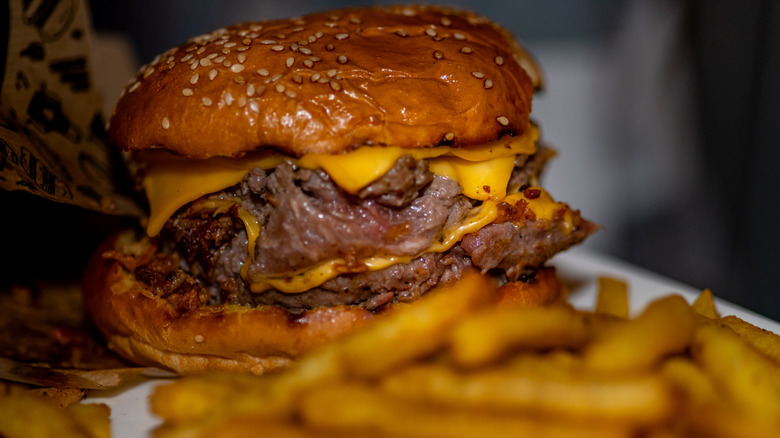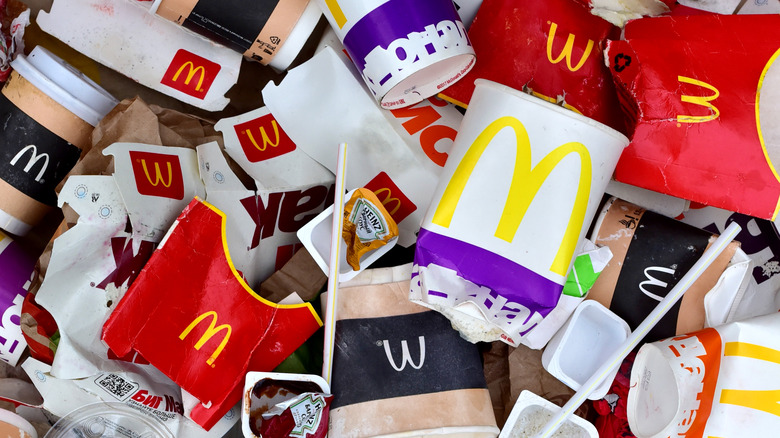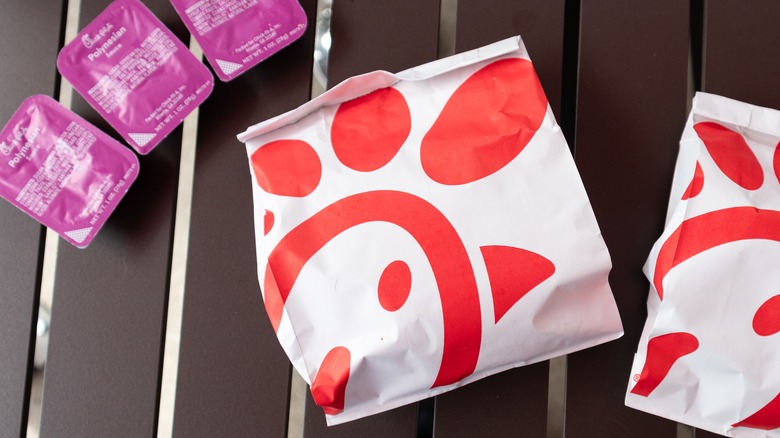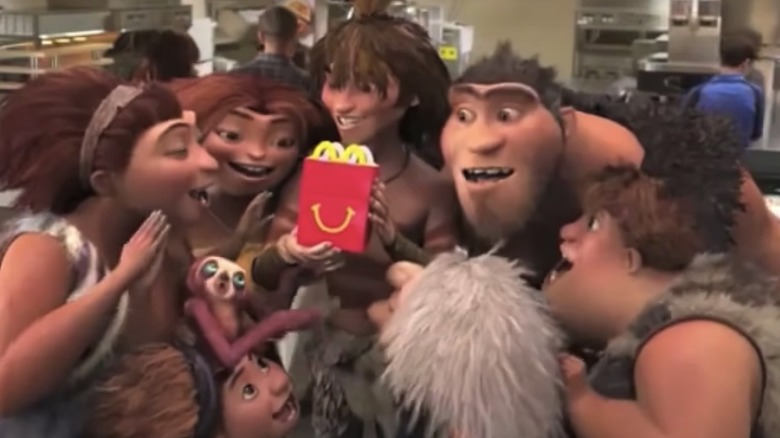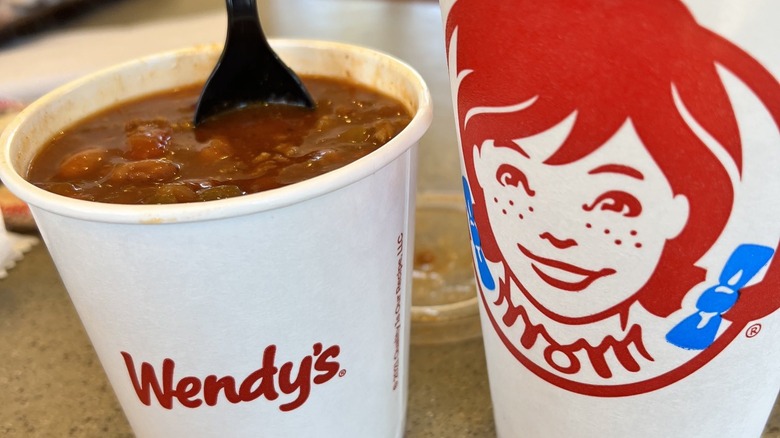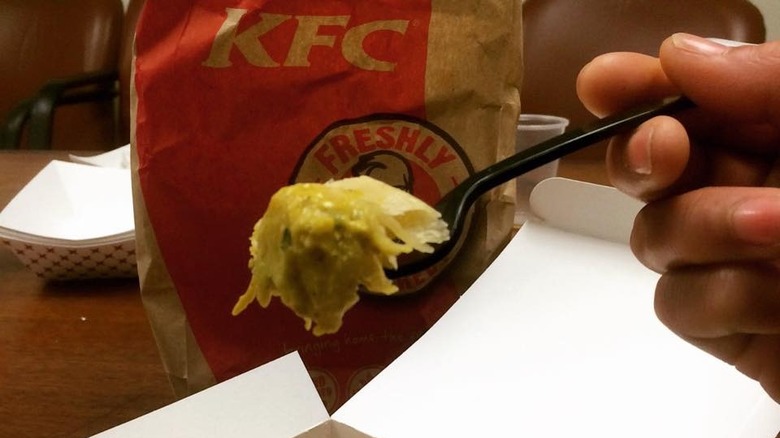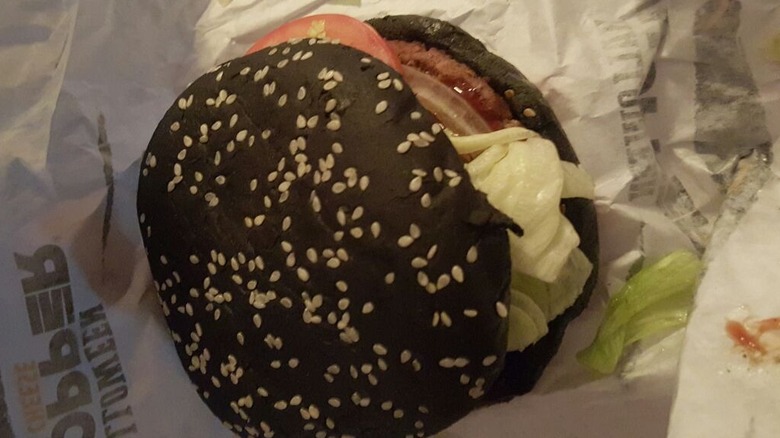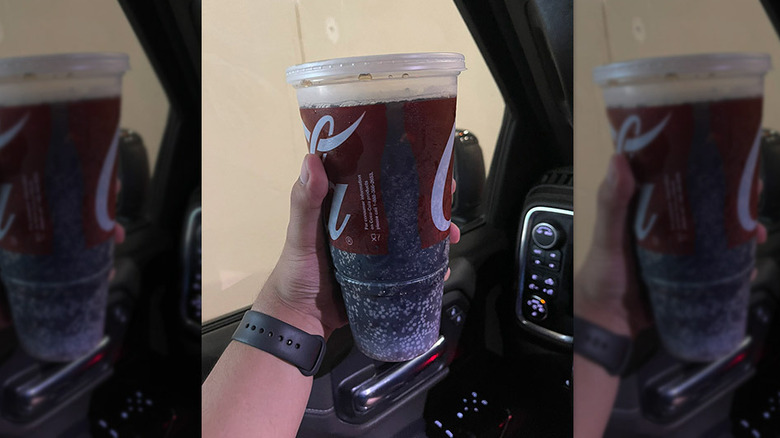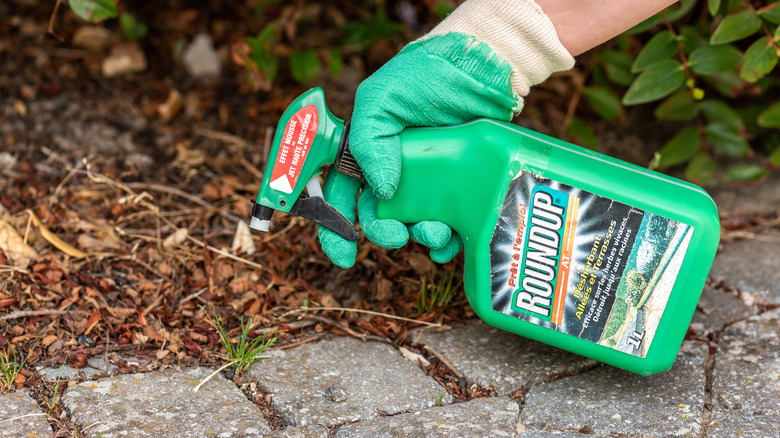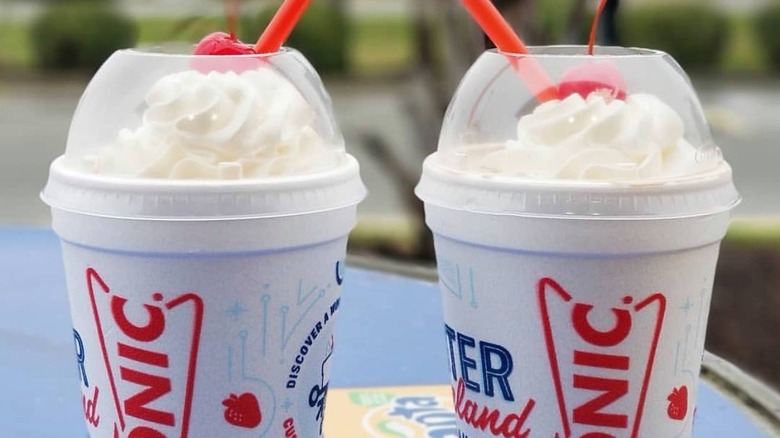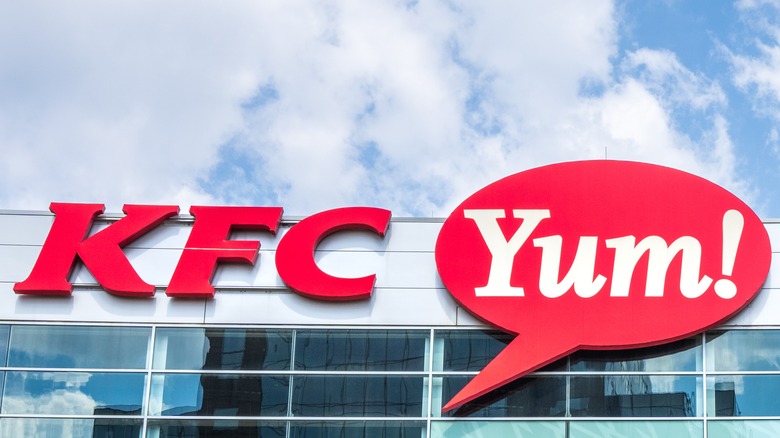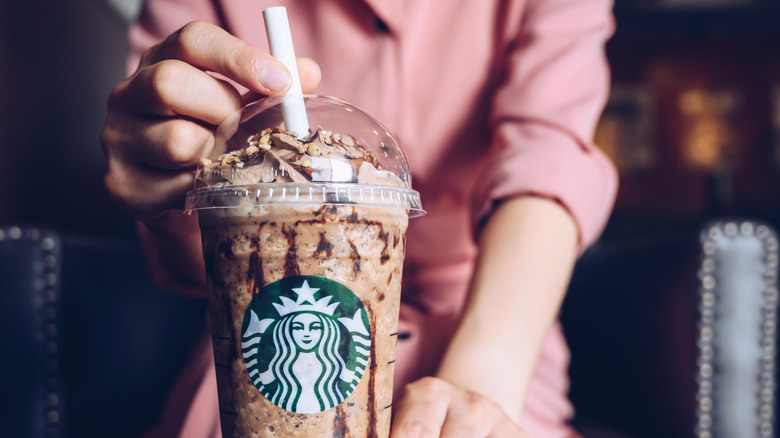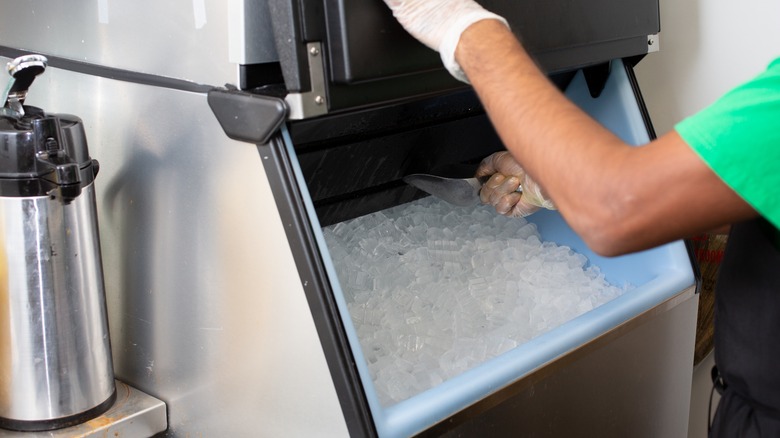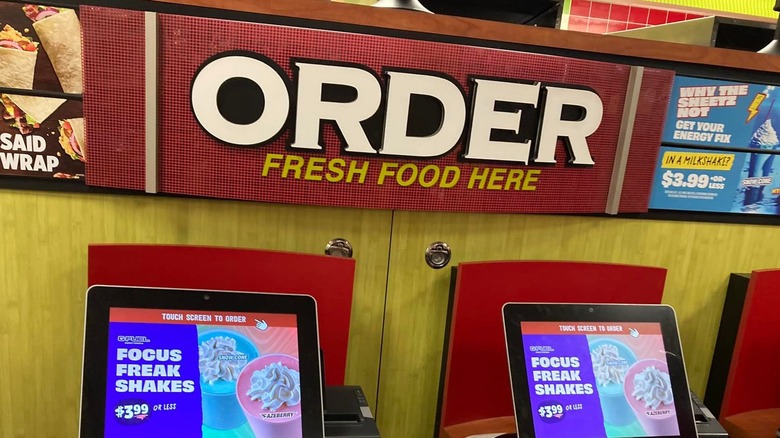Gross Things You Should Know About About Every Major Fast Food Restaurant
Fast food ain't pretty. There is no way to keep prices low and wait times minimal without cutting a few corners and sneaking in a splash of preservatives. Instead, the industry is a shining example of humanity's ingenuity gone too far. Forget flying cars — hot fresh meals can be dropped off on your doorstep in a few clicks, but those meals are slowly killing us. The grossest thing in fast food is the food itself. We're pretty much past that now, though. We can all agree that fast food isn't bringing many benefits to our physical health, and we can also agree that in moderation, fried chicken sandwiches are absolutely delicious. Now that delivery is so easy we can become even more protected from the stained yellow interior of fast food joints, with their constant aroma of fried oil that reminds us what our digestive system is about to go through.
Just selling unhealthy food is not enough. To be truly gross is to take things too far. It can be easy to look past the shady things and nerve-wracking statistics that come out about fast food. Every now and then though, a local franchise with poor management or an entire fast food company with a greed problem crosses the line.
Whether it's political scandals, eye-popping nutrition statistics, or shocking lapses in common sense cleanliness, these shameless secrets might change the way you look at your favorite hamburger.
Fast food might be healthier than the packaging
When ordering fast food, we all willingly sign up for the inherent risk of the food itself, but nobody warned us about the wrapper it comes in. Allow us to do so now: Fast food packaging has high particles of poly-fluoroalkyl (PFAS), as high as 7x the limit recently set in California and 3500% higher than regulations in some countries.
As these chemicals come under further scrutiny, Consumer Reports dropped the bombshell: As recently as 2021, eight major restaurants, including several who had previously announced efforts to phase out forever chemicals, still have packaging with PFAS levels soon to be illegal in California. The state's recently passed law limits PFAS exposure in food packaging to 100 ppm (parts per million). Denmark has set the strictest limit thus far, leading many to define packaging containing a toxic dosage of PFAS as anything higher than 20 ppm. The Consumer Reports study found that items like paper bags for French fries had as much as 250 ppm.
Also known as "forever chemicals," You might recognize PFAS as the exact same killer chemicals from the film "Dark Waters." These toxins, which were proven capable of wiping out herds of cattle, keep your fries warm. There is a lot of stuff in junk food that doesn't exactly scream healthy, but it turns out it's what's on the outside that really matters.
Chick-Fil-A Sauce is not the boss
There is a reason for the burst of flavor in a great sauce. Most major fast-food restaurants sneak some serious calories into their fix-ins and dressings, using the power of fat and sugar to bring extra smack to entrees and sides.
It's a problem across the industry, but one particular sauce takes things up a notch. Chick-Fil-A's best sauce didn't earn its legendary reputation through healthy eating, but you might be surprised to hear that there is more fat in one 28g sauce pack than in an 8-count nugget. You'd never dream of feeding a child 24 chicken nuggets in one sitting, but three packets of sauce arguably brings more damage.
This super sauce is a combination of ranch, barbecue, and honey mustard mashed together with a whole lot of soybean oil. The fatty ranch, bolstered by the sweetness of BBQ and honey mustard, creates a blend as delicious as it is deadly.
Unfortunately, their signature add-on is not the only dip we caught slipping. The Polynesian sauce's sweetness comes with an even higher sugar content. Two packets would be close to 50% of your entire day's sugar intake.
Fast food spends alot of money advertising to children
A recent fast food advertising study found that kids aged 2-5 will see 2.3 fast food ads daily on TV alone.
The study dropped all sorts of interesting nuggets about the industry's advertising plans for minors. Most surprisingly unsurprising is the demographic shift of the ad targets. While the overall number of ads viewed by preschoolers has decreased since 2011, it has increased for both black and Hispanic youth. They are subject to a disproportionate amount of advertisements with the goal of influencing children's diets and eating choices.
Six companies — McDonald's, Subway, Burger King, Domino's, Yum! Brands, and Wendy's, represented more than 70% of all ads seen by young viewers. We'll give credit where it's due — Mcdonald's and Burger King's have joined the Children's Food and Beverage Advertising Initiative, a group of restaurants that promise to only advertise products to children that meet strict nutrition criteria. They are the only two major fast-food chains currently signed on.
TV is becoming the least of our problems. Even more troubling is the wide-open market of the internet. Youtube channels subtly feature food products and popular brands at a much higher rate than traditional TV product placements. Cigarette companies aren't allowed to advertise to minors, but companies peddling those same addictive properties spend billions winning over future customers.
Everything about Wendy's Chili
A small percentage of iron stomachs with a passion for food waste solutions say party on, but for the rest of us, this chili is full of red flags. The fast food giant's spicy side item has been around since the menu only had a handful of choices, serving as a humble side to Frostys and burgers nationwide.
It turns out, the secret to Wendy's Chili's longevity is a few days worth of marinating. The chili's main ingredient is hamburger meat that has been sitting around too long and isn't fit to be sold on a burger. This unsold meat is frozen and combined with beans, tomatoes, and a dry bag of spices to start a new life as chili.
The company doesn't seem too ashamed to admit it, either. Founder Dave Thomas wrote in his autobiography "Dave's Way" that the chili's purpose on the menu is to use the leftover meat from grilling fresh burgers. Employees routinely back up this information, explaining that the company recipe involves rinsing unsold beef, boiling it for hours, and then rinsing it again before combining it with a dry bag of spices. This unique food waste solution doesn't necessarily mean the chili will cause harm, but it's not the most appetizing cooking process, either.
KFC's Chicken Pot Pie is ½ fat
The Chicken Pot Pie is KFC's version of Wendy's Chili, a humble sideshow menu item that has remained unchanged for over 30 years, (and also made out of leftover meat.) While the details behind this recipe do not inspire confidence, it's natural to think that the Chicken Pot Pie is a more health-conscious selection on a menu full of fried, breaded, and popcorn chicken. Unfortunately, adding peas, carrots, and potatoes and removing unhealthy chicken skin isn't enough to elevate this pot pie. It's all counterbalanced by an incredible percentage of fat content.
While the Chicken Pot Pie only has 720 Calories, an absurd 52% of them come from fat. That is a higher fat content than an Arby's sandwich called the "Meat Mountain." Perhaps even more inspiring is the whopping 25 grams of saturated fat included in each Chicken Pot Pie, 125% of your recommended daily value.
You would need to eat 10 pieces of KFC's original recipe fried chicken wings for that kind of saturated fat. Most shocking of all, the chicken pot pie has more calories and saturated fats than the KFC Double Down, which, of course, is a bacon sandwich with two pieces of fried chicken replacing the bread.
Burger King's Halloween burger would be better on St. Patrick's Day
Burger King has done many strange things to sell its hamburgers, but none have had such lasting effects as its Halloween black Whopper. The brand told the world the bun was turned black with the addition of A.1. Steak Sauce, but customer's stool samples showed additional ingredients.
While there is trace A1 flavoring in the bun, food dye was responsible for most of the darkening. Scientists threw together a colorful combination of yellows, blues, reds, and oranges to paint the burger black. The dyes survived digestive systems and came out greener than the Chicago River in March.
The promotion was quickly trending on Twitter for all the wrong reasons, as customers spent days trying to get the green substance out of their digestive system. It's not the first time a BK ad campaign has flopped, and it won't be the last. Nor will it be the last time a fast food meal wreaks havoc on our digestive system. Hopefully, though it will be the last time fast food brings color to the bathroom.
Many menus are getting unhealthier
In a 2019 study of fast food nutrition, The Academy of Nutrition and Dietetics found "broadly detrimental changes" in American fast food offerings. The study looked at 30 years of fast food and found an increase in energy, sodium, and portion size, creeping up sometimes at a rate of 4.6% of your daily value per decade.
Even as meat alternatives and fruit salad side items emerge, most fast food offerings are still going downhill. How could this happen as we simultaneously become more health conscious? For every step forward, companies took two steps back, especially once medium, large, and XL options became the norm.
The soda sizes are great examples of this exponential growth gone wrong. Mcdonald's soda had one size in 1955; 7 ounces. Nowadays, an "extra small" is 12 ounces. Cup sizes peaked at 42 ounces during the Supersized period before settling in at around 30 ounces for a large. That additional 23 ounces of coke brings an increase of 50 grams of sugar in your beverage alone. Many classic menu items have seen similar growth, like French fries. In 1955, there was only one size; just under 3 ounces of golden potatoes. The modern large size more than doubles your overall potato count.
Panera Bread failed its drug test
Panera Bread's bagels share active ingredients with the pesticide Roundup. A recent study tested 44 restaurants and found Glyphosate residue in 39 of them. Most of the biggest culprits were multigrain or whole grain bread items, often touted as a healthier choice. Panera's whole grain bagel was the biggest loser of this study. Three separate bagels had between 336, 522, and 677 Glyphosate parts per billion. That means that some of these bagels contained more than the European Food Safety Authority's maximum daily intake recommendation of 500 ppb per day, all in the span of two toasted bagel halves. These little details can make Panera's clean-eating marketing campaign feel dubious.
The good news is that the bagel was the only product that tested higher than food safety limits. Still, no amount of Glyphosate does anything but increase the potential risk of several cancers and liver diseases. Even the World Health Organization had to admit that this ingredient is "probably'"carcinogenic to humans.
The amount of pesticides caught sneaking into our food and water is alarming across the board. Consumers shouldn't have to choose between white bread that's not much more than flour and sugar and whole grain bread with a side order of weed killer.
Sonic's won some awards for all the wrong reasons
America's drive-in didn't build an empire on salads and gluten-free entrees. Its menu full of hot dogs and milkshakes might make for an indulgent treat but we've got to draw the line somewhere. While there are a few heart-stopping burgers and sides, the Oreo Peanut Butter shake packs in award-winning calorie counts. The 2019 Extreme Eating Awards nicknamed the dessert a "disaster shake" capable of packing almost an entire day's calories into 32 ounces.
Remember that KFC Pot Pie we mentioned? This menu item somehow manages to do more with less. The large version of this shake has a legitimate argument for the unhealthiest thing you can order in all fast food. There are 1,720 calories in the large shake, a few crackers away from the recommended daily allowance. Among the massive haul of calories that makes up the Oreo Peanut Butter Shake is a higher fat content than Wendy's Triple Big bacon Cheddar Cheeseburger (102 grams of fat). You might write all that off due to peanut butter's high natural fat content, but the 107 grams of sugar push it all over the edge.
Yum! Brands fought to redefine the workweek
Every large chain has a few skeletons in the closet, but Yum! Brands needs a walk-in. As the parent company of several fast food chains, including KFC, it has enjoyed its fair share of time in the spotlight. Despite its constant public bouts with human and animal rights groups, like any great corporation, the real damage is done behind closed doors.
Publicly, most fast food companies have nothing but glowing remarks to shower upon employees. Offline, however, brands like Yum! have been busy in Washington with all sorts of lobbying efforts undermining their own workforce. While the company did encourage employees to stay home during the pandemic and offered pay and medical support, it hasn't always taken such a supportive stance with its workers. The brand fought to amend an aspect of the affordable care act that changed the definition of "full-time" employment from 30 hours to 40 hours, drastically reducing its responsibility to provide employees with healthcare.
It's not the first time Yum! Brands have shown up on the other side of workers' rights. As a prominent member of the National Restaurant Association in 2011, it focused heavily on lobbying politicians to repeal sick leave requirements. Ugh.
Starbucks Frappuccinos have more sugar than a can of Coke
Many people wouldn't dream of starting their day off with the caffeine boost of a can of soda, but after a long week at work, why not treat yourself to a Friday Frappuccino? A recent expose of Starbucks' worst menu items gave us plenty of reasons to avoid the drink.
The worst offender is the Caramel Ribbon Crunch Frappuccino, a drink that lists sugar six different times on its ingredients list, mostly under the code name "syrup." The Tall version of this Frappuccino fits more than 42 grams of sugar and 15 grams of fat into a 12-ounce frame, compared to 39 grams of sugar per 12-ounce Coke can.
Unfortunately, it's far from the only sweet iced beverage on the menu that you'll pay for later. Of the 10 coffee Frappuccinos currently available on the Starbucks menu, only three have less than 37 grams of sugar. The only Frappuccino with less than an entire day's worth of sugar in Tall size was the Espresso Frappuccino, with a paltry 28 grams.
Looking for a sweet iced substitute? You should skip the fruit refreshers. While these drinks have less sugar than a Frappuccino, they are currently facing a class action lawsuit alleging the beverages are mainly just water, grape juice concentrate, and sugar. All it takes is a quick look at the ingredient list to see words like "açai" missing from a drink named Strawberry Açai.
The ice machine might have more bacteria than the toilet bowl
While the FDA defines ice as food, most restaurants don't tape sell-by dates onto cubes. There are many ways for nastiness to sneak its way inside ice machines, and best case scenario, those machines are only getting sanitized once every few weeks. Bacteria from hands reaching into the machine and from the water used to make the ice sits in the machine while the freezing environment allows it to stick around and accumulate.
The Daily Mail checked out 10 fast food restaurants and found that six of them, including Mcdonalds, Burger King, Starbucks, and KFC, had ice machines with higher bacterial content than the water in the toilet bowl. Optimists might take that statistic as a great example of clean restaurant bathrooms, but most customers would think that one speck of fecal matter in an ice cube is too much.
These surprising test results were no anomaly. Other reports found that dirty ice water is a frequent comment on North Carolina restaurant's health cards and has even contributed to a few Norovirus outbreaks.
Sheetz microwaves its grilled chicken
In Sheetz's made-to-order system, the "M" can also stand for microwave. According to multiple former employees, burgers, sides, and, yes, even the grilled chicken's in-store cooking process involves not much more than two minutes in the microwave.
Employees explained that meat products arrive frozen. Most of the gas station/fast food combo stores only have a microwave and a deep fryer, so anything that doesn't go in the fryer is reheated in the science oven. One Redditor even claimed that Sheetz even puts fake grill marks on its hamburgers and chicken sandwiches to finish the ruse.
Considering that Sheetz is a glorified gas station serving fast food, it shouldn't come as too big of a surprise to find out how many different menu items include a stop in the microwave. (Did you really think they were cooking all that rice to order?) Especially when ordering a sandwich from a place that also sells diesel, nobody is expecting a grillmaster running the show back there, but not even having a flat top in a restaurant that serves grilled chicken is a bit gross.
